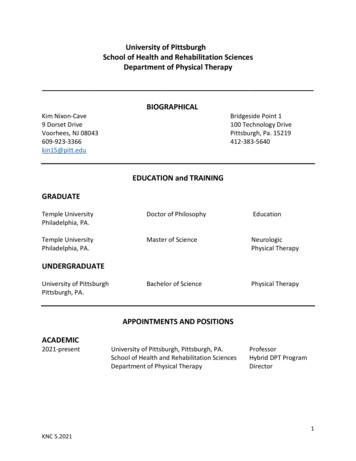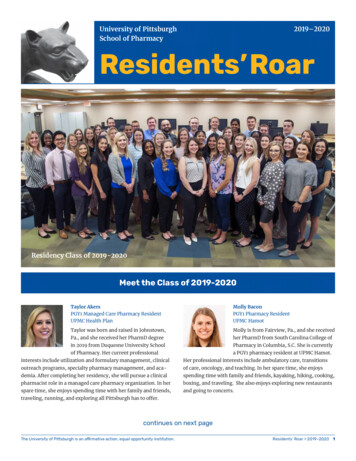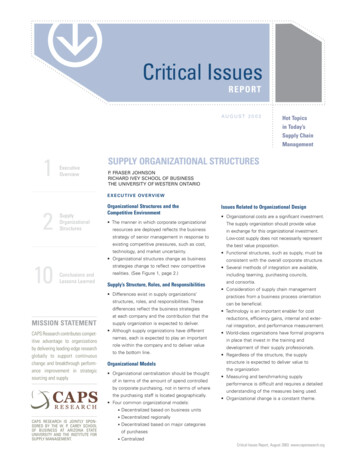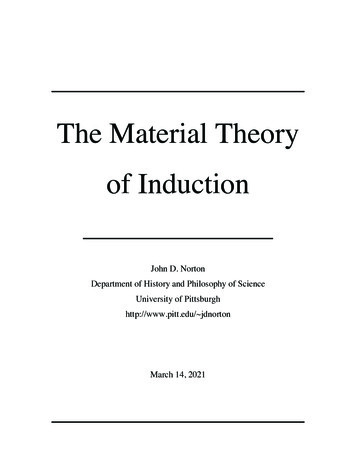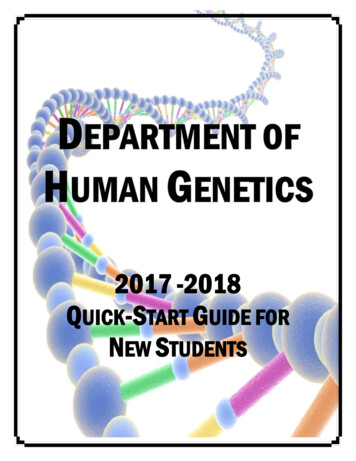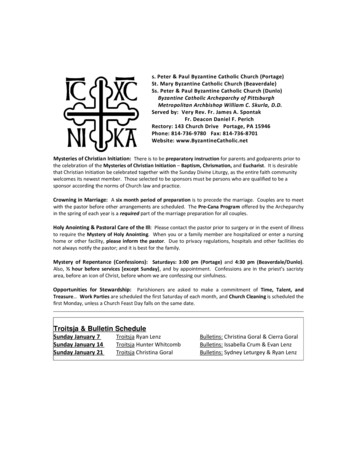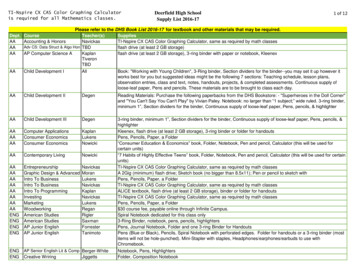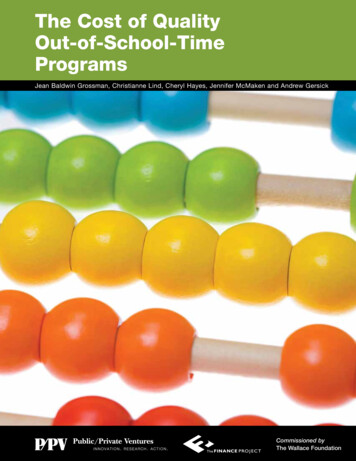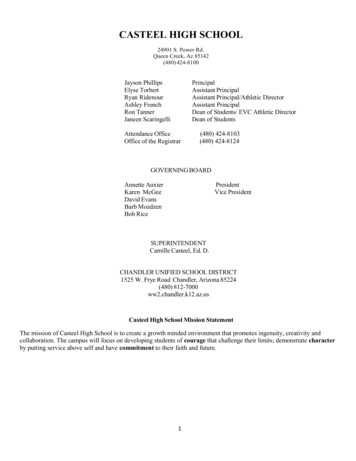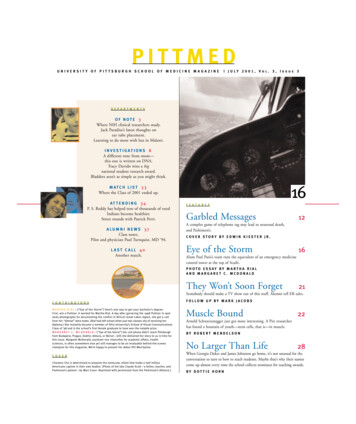
Transcription
2088txt 1to21c4 7/16/01 2:40 PM Page 1PITTMEDUNIVERSITY OF PITTSBURGH SCHOOL OF MEDICINE MAGAZINE J U LY 2 0 0 1 , Vo l . 3 , I s s u e 3DEPARTMENTSOF NOTE 3Where NIH clinical researchers study.Jack Paradise’s latest thoughts onear tube placement.Learning to do more with less in Malawi.I N V E S T I G AT I O N S 8A different note from mom—this one is written on DNA.Tracy Davido wins a bignational student research award.Bladders aren’t as simple as you might think.M AT C H L I S T 3 3Where the Class of 2001 ended up.AT T E N D I N G 3 4P. S. Reddy has helped tens of thousands of ruralIndians become healthier.Street rounds with Patrick Perri.ALUMNI NEWS 37Class notes.Pilot and physician Paul Turnquist, MD ’94.L AST C ALL 40Another match.16FEATURESGarbled Messages12A complex game of telephone tag may lead to neuronal death,and Parkinson’s.COVER STORY BY EDWIN KIESTER JR.Eye of the Storm16Alum Paul Paris’s team runs the equivalent of an emergency medicinecontrol tower at the top of Scaife.P H OTO E S S AY BY M A RT H A R I A LAND MARGARET C. MCDONALDThey Won’t Soon Forget21Somebody should make a TV show out of this stuff. Alumni tell ER tales.CONTRIBUTORSM A R T H A R I A L —[“Eye of the Storm”] Here’s one way to get your bachelor’s degree:First, win a Pulitzer. It worked for Martha Rial. A day after garnering the 1998 Pulitzer in spotnews photography for documenting the conflict in Africa’s Great Lakes region, she got a callfrom her “almost” alma mater. (Rial had left school when just two classes shy of receiving herdiploma.) She instantly became a member of Ohio University’s School of Visual CommunicationsClass of ’98 and is the school’s first female graduate to have won the notable prize.M A R G A R E T C . M C D O N A L D —[“Eye of the Storm”] Her cell phone didn’t reach Pittsburghfrom Budapest, Prague, Dublin, Ankara, or Beirut—still she delivered her story to us in time forthis issue. Margaret McDonald, assistant vice chancellor for academic affairs, healthsciences, is often somewhere else yet still manages to be an invaluable behind-the-sceneschampion for this magazine. We’re happy to present her debut Pitt Med byline.COVERCharleen Chu is determined to pinpoint the molecular villain that holds a half millionAmericans captive in their own bodies. (Photo of the late Claude Scott—a father, teacher, andParkinson’s patient—by Marc Esser. Reprinted with permission from the Parkinson’s Alliance.)FOLLOW UP BY MARK JACOBSMuscle Bound22Arnold Schwarzenegger just got more interesting. A Pitt researcherhas found a fountain of youth—stem cells, that is—in muscle.BY ROBERT MENDELSONNo Larger Than Life28When Georgia Duker and James Johnston go home, it’s not unusual for theconversation to turn to how to reach students. Maybe that’s why their namescome up almost every time the school collects nominees for teaching awards.BY DOTTIE HORN
2088txt 1to21c4 7/16/01 2:40 PM Page 2DEAN’SMESSAGEPITTMEDEDITOR IN CHIEFErica LloydC R E AT I V E D I R E C TO RGary CravenerART DIRECTORElena Gialamas CerriSENIOR EDITORRobert MendelsonA S S O C I ATE E D I TO RDottie HornP RO D U C T I O N CO O R D I N ATO RChuck DinsmoreS TA F F CO N T R I B U TO R SMark Jacobs, Edward HumesOBITUARIES CONTRIBUTORMacy Levine, MD ’43CHIEF EDITORIAL ADVISORSteven L. Kanter, MDEDITORIAL ADVISORSTimothy Billiar, MDJonathon Erlen, PhDMichael Gorin, MD, PhDJohn S. Lazo, PhDPat Levitt, PhDMargaret C. McDonald, PhDRoss Musgrave, MD ’43Paul Paris, MD ’76Charles F. Reynolds III, MDIan Reynolds, PhDEllen Wald, MDSimon Watkins, PhDMark Zeidel, MDOFFICE OF PUBLIC AFFAIR SRobert HillMary Ann Aug, PhDPitt Med is published by the Office of theDean and Senior Vice Chancellor for the HealthSciences in cooperation with the alumni andpublic affairs offices. It is produced quarterly foralumni, students, staff, faculty, and friends ofthe School of Medicine. PR 3081The University of Pittsburgh is an affirmativeaction, equal opportunity institution.Copyright 2001, University of Pittsburgh2PITTMEDOne call home from my daughter Raleigh, whoat the time was an undergraduate atWesleyan, sticks with me: “Dad, you wouldlove my lit professor!” She was right. Franklin Reeve, her professor, had in fact taught me years before when I was atColumbia, inspiring me to major in Russian literature and torevel in it to this day. (Reeve’s clarity and elegance were passeddown to his celebrity son, Christopher, whose words at arecent Pittsburgh conference moved many a scientist, as youwill see in our p. 22 story.)I would bet that my image of Professor Reeve exhorting me to learn the Russian languageso that I could fully appreciate Pushkin is as clear as Raleigh’s. We don’t ever forget exceptionalmentors. I’ve been lucky to have so many: my mother, a teacher herself; the headmistress ofmy high school; Lionel Trilling, another literary giant and my undergraduate advisor atColumbia—and there was Clifford Pilz. Pilz was a crusty, irascible, and occasionally fearsomeVA internist who came from a long tradition of physicians employing their clinical sensesbefore they reached—as they might now—for the microarray and the confocal microscope.He would have us read a daily lesson in Bailey’s Physical Signs in Clinical Surgery (1927) as ifit were the Talmud. Here is Pilz quoting Bailey on aortic aneurisms: It is often a perplexingproblem to decide whether the pulsation of an abdominal swelling is transmitted from aneighboring artery or whether the swelling itself is pulsating. Great help can be obtained by fixing two match sticks with plasticine onto the skin overlying the swelling. If the pulsation istransmitted, the movement of the matches during each throb of the pulse is vertical, and thematches remain parallel with each other. On the other hand, if the swelling is truly expansile,the excursions of the match heads are deflected to the left and to the right. It worked—ofcourse! The knowledge that Pilz passed along to me still has a freshness and immediacy, even atmy age certaine. He believed that most physical diagnosis could be accomplished with a tonguedepressor, flashlight, pencil, magnifying glass, speculum, stethoscope, thermometer, tendonhammer, set of finger cots, tape measure, and, of course, a box of wooden matches. Pilz feared,however, that the modern graduate of medicine would soon approach a routine outpatientvisit with a mobile pantechnicon, and be unable to formulate a diagnosis without this aid.During the graduation rush we pause to salute the men and women who, by their veryexample, fan the flames of inquiry. Those recognized with teaching awards are usually repeatoffenders—much like Professor Reeve. It is notable that Paul Rogers, of critical care medicine,was honored three times over this year; it’s equally revealing that Georgia Duker and JamieJohnston, whom you’ll get to know in this issue (p. 28), were recognized for their dedicationto our students yet again.The recipe for unforgettable teaching seems to be part genius, part passion, part scholarship, part intimacy, and perhaps, part magic. My compliments to the chefs.J U L I A M A RO U S ST R A U TPUBLISHERArthur S. Levine, MDArthur S. Levine, MDSenior Vice Chancellor for the Health SciencesDean, School of Medicine
2088txt 1to21c4 7/16/01 2:40 PM Page 3OFNOTEDevoted to noteworthyhappenings at themedical school. . .To stay abreast ofPitt health sciencesnews, see http://www.They’ve ArrivedPAT R I C I A N AG LEhealth.pitt.eduIn 1907, a group of upstart clinical investigators were chatting on the Atlantic City boardwalkduring a conference break. Heads nodded in agreement: They needed a venue for presentingpapers, yet they hadn’t reached the age of 45, so they couldn’t be considered for acceptanceinto the revered Association of American Physicians. So they decided to form their ownorganization—the American Society of Clinical Investigation (ASCI). As the century unfolded,ASCI would set the standards for emerging generations of clinical researchers, claiming 15Nobel and 216 Institute of Medicine laureates among its alumni. This year, the elite ASCIinducted two more University of Pittsburgh professors: Alan Wells, who is the Thomas J. GillIII Professor of Pathology, and Augustine Choi, chief of pulmonary, allergy, and critical caremedicine. Wells is investigating why and how cells move around—especially in relation totumor invasion and wound repair. Choi’s work focuses on lunginjury. “He is probably one of the very brightest pulmonary researchers in the country,” notes MarkZeidel, chair of medicine and also an ASCImember. —ELWells (left) and Choi have been recognized asamong the nation’s top clinical investigators.FO OT NOTEA glossary in this year’s Scope andScalpel program offers some newdefinitions, among them—S4: Mythical extra heart soundcaused by chronic hypertension;“Um, sure Dr. Shaver, I can hear theS4 . . . just before the S5, right?”NIH RESEARCHERS HITT H E B O O K S AT P I T TThere are only two places in the country where theNational Institutes of Health (NIH) sends its clinicalinvestigators for training. One is Duke University. Theother is Pitt. The School of Medicine’s new ClinicalResearch Training Program was designed to train Pittfellows and junior faculty; now NIH researchers willparticipate through intensive summer course work inPittsburgh and teleconferencing. —DHJULY 3
2088txt 1to21c4 7/16/01 2:40 PM Page 4OFNOTEPA R A D I S E R E C O N S I D E R SP H OTO D I S CEAR TUBE PLACEMENT BY D OT T I E H O R NWhen he was a practicing pediatrician, Jack Paradise was frustrated by the lack of scientifically based guidelines for treating the most common childhood illness—middle ear disease.So he has devoted his career to studying the condition. On April 19, the University ofPittsburgh professor of pediatrics published an article in the New England Journal ofMedicine asking, “Does delaying placing ear tubes in children with middle ear effusionadversely affect their development?” Effusion refers to the condition of fluid lingering in themiddle ear cavity, sometimes for months, after an acute ear infection. The condition causesdiminished hearing—often during a time of critical brain development. Many have debatedwhether the temporary reduction in sensory input irreversibly damages a child’s speech, language, and cognitive development. Inserting tubes restores normal hearing. First surgeonsincise the eardrum to suction out the fluid. Then they place the tube through the eardrum,which carries air into the middle ear cavity, preventing fluid buildup. But the procedure also carries risks. For example, it can scar the eardrum or cause a perforation, with unknown effects on the hearing loss associated with aging.To answer his question, Paradise and colleagues monitored 6,350 infants.Those who developed effusion were randomly placed in one of two groups.Either they received the tubes as soon as was practical, or they received tubesonly if effusion continued (two-thirds of the children in this group neverreceived tubes). Paradise et al. evaluated the children at age 3, and found nodevelopmental differences. The “wait-and-see” group appeared no worse off.He will continue to test the children until they are 6. “The study results givepause and I think at this point tip the scale in the direction against doinganything—if the child’s development is the main concern,” he says.Faculty SnapshotsDIn the United States, one in 75 people contractsmelanoma, and 7,800 die from the disease eachyear. In the May 1 issue of the Journal ofClinical Oncology, John Kirkwood, professor ofmedicine, reported that patients with advancedmelanoma who were treated with interferon alfaKirkwood4PITTMED2b following surgery had a relapse rate 33 percent lower than those treated with the GMK antimelanoma vaccine following surgery. In addition,those who received the interferon treatment hada 33 percent lower death rate than those treatedwith the vaccine. Kirkwood’s earlier research ledthe Food and Drug Administration, in 1995, toapprove interferon alfa-2b as the first adjuvanttherapy for high-risk melanoma.In April, colleagues honored the life andcareer of Thomas Starzl, distinguished serviceprofessor of the health sciences. ScientistsA portrait of Starzl now hangsfrom around the world presented papers for aamong images of other Pitt greats.Festschrift and celebrated the man who performed the world’s first successful liver transplantin humans in 1967 and has been making transplantationbreakthroughs ever since. “The biggest limitation now isthe shortage of organs,” says Starzl. His current researchfocuses on how to make animal organs work in humans.“What we’re trying to do is insert human genes into pigsand then to clone the pigs. We’re working with the peoplewho cloned Dolly. . . . If you can clone, you can produce alot of pig donors.” —DHC O U RT E SY U P M C N E W S B U R E A Uoes the web play a big role in keeping AlleghenyCounty residents healthy? “Reports of the information technology revolution are greatly exaggerated.It doesn’t mean it’s not going to happen. It hasn’t happened here yet,” says Charles Friedman. The professor ofmedicine and director of the University of PittsburghSchool of Medicine’s Center for Biomedical Informaticsserved in an advisory capacity on a study of how countyresidents use the web for health care. Some findings ofthe effort undertaken by Pitt, the National Library ofMedicine, and the Jewish Healthcare Foundation: 50 percent of county residents relied only on their doctors forhealth information; 25 percent sought information tosupplement what they received from their doctors, mostoften from the Internet, books, and magazines. Fewerthan 3 percent reported that their doctors have referredthem to web sites.
2088txt 1to21c4 7/16/01 2:41 PM Page 5Becker: Expect the Unexpected“You have to keep an open mind, to be ready for the unexpected.”Dorothy J. Becker (Fel ’76) will tell you that is the mark of a goodclinical researcher.Becker, who won the Medical Alumni Association’s 2001 McEllroyAward, which recognizes outstanding physicians who did their traininghere, is more than willing to be surprised.The director of the division of endocrinology and of the diabetessection at Children’s Hospital of Pittsburgh arrived from her native SouthAfrica in 1974 for a two-year endocrinology fellowship at Children’s.Initially interested in nutrition and hormones, Becker has contributed tothe medical community’s understanding of complications associatedwith diabetes in childhood; she’s also pursuing ways to predict theonset of the disease in those at risk. And recently, she was the coauthorof a study on the relationship between diabetes and multiple sclerosis.It has been 25 years since Becker completed that endocrinologyfellowship. What has kept her in Pittsburgh is the chance to collaboratewith physicians here. “The big thing is that those relationships,” shesays, “have made our research great for two decades.” —JLBeckerTHE 52-MILE,800-ARTICLE MANF L A S H B AC K“[It was] Thomas Parran who led the nation afterWorld War I to develop a strategy for controllingvenereal diseases. He was courageous, and if youthink that it’s difficult for the surgeon general todayto talk about sex, Thomas Parran was not evenallowed to say the word ‘syphilis’ on the radio. . . .When he left the Office of the Surgeon General in1948, [Parran] came here to the University ofPittsburgh to be thefirst dean of theGraduate School ofPublic Health.”—Surgeon GeneralDavid Satcher,speaking at theUniversity’s 2001CommencementLEA RT V I LMooreOn Wednesdays at 4:30 a.m., Ernest Moore,MD ’72, sets out into the cool morning darkness with running partners from his lab. It’spart of the professor of surgery at theUniversity of Colorado Health SciencesCenter’s spring training for his annual 52mile ultramarathon. During the four-hour run,the topic of conversation is likely to turn toresearch pursuits, making it a doubly productive time for Moore, who has published nearly 800 articles throughout the past 25 years.This May, the prolific Moore won the Hench DistinguishedAlumnus Award given by the Medical Alumni Association.David Feliciano, professor of surgery at Emory Universityin Atlanta, Georgia, notes that Moore is the authorof one of the most significant articles ever writtenon hepatic injuries in modern trauma. That reviewarticle, published in the American Journal ofSurgery in 1984, helped pave the way for a majorshift in how surgeons treat liver trauma—from intervening operatively in almost all cases to a muchmore hands-off approach.Other studies by Moore helped change the way surgeons treat trauma to the spleen and blunt rupture ofthe descending thoracic aorta. He is now investigatinghow intercellular signaling can lead to multiple-organfailure (one of the most common reasons that patientsdie in the intensive care unit after trauma). —DHJULY 5
2088txt 1to21c4 7/16/01 2:41 PM Page 6OFNOTEAppointmentsAs the new chair of the Department of Pediatrics,David Perlmutter plans to emphasizefellowship training. He notes: “To train thenext generation of academic pediatricians, we need torecruit physician-scientists who can be mentors.”The pediatrician’s own research into alpha-1PAT R I C I A N AG LEantitrypsin deficiency, which can cause liverdisease in children and emphysema in adults,has lent insight into a cellular process implicated in many diseases. “There is a mechaPerlmutternism in every cell whereby the cell can recognizewhen a protein is not folding correctly and dis-Lazarus department store employees painted 55butterfly mobiles that will hang in oncology patientrooms at UPMC Presbyterian and Shadyside.pose of it,” says Perlmutter. He refers to this as thequality control mechanism of the cell; his lab has offered somethe faculty—are the ones who sell it.” Capelli has a BS in engineeringimportant information on how that mechanism works.and an MD. He holds eight US patents.The new director of the Office of Technology Management,Bernard Goldstein, former director of the Environmental andChristopher Capelli, plans to further educate Pitt faculty and staff aboutOccupational Health Sciences Institute, in New Jersey, will join thehow technology is turned into a commercial product—and the role theyDepartment of Medicine. Most of his time, however, will be spent downcan play in that process. “Technology doesn’t sell itself,” says Capelli.the street; he is now dean of Pitt’s Graduate School of Public Health.“The people who know the most about the technology—the scientists,He comes to Pittsburgh from New Jersey by way of Malaysia. Globalissues in environmental medicine areamong his most recent fascinations, asB U M P E R TO B U M P E Ris the interface between science and publicSometimes there’s nothing like a good automotive metaphor. At a May meeting of 100-plusprofessors and students, the call for a “tune-up” of the curriculum elicited discussion aswell as nods of support. To ensure that Pitt med graduates are among the best preparedin the world, the school holds this novel Curriculum Colloquium each year. Leaning acrosstables, attendees passed microphones to one another, considering the triumphs and trials of problem-based learning, the need to deepen the scope of genetics study, a proposal to increase scholarlyresearch opportunities, amongother issues. While participantsnoted that Pitt’s curriculum ishailed as model, there was alsoa growing recognition that itwas time to make changes tostay ahead of the pack.policy. Goldstein’s talents are well known inpublic health sectors: He was the Environmental Protection Agency’s assistantadministrator for research and developmentand chaired the Institute of Medicine’s(IOM) Role of the Physician in Occupationaland Environmental Medicine effort and theNational Institutes of Health’s ToxicologyStudy Section. He is a member of the IOM.—DH & ELJ O E K A P E LE W S K I6PITTMEDGoldstein
2088txt 1to21c4 7/16/01 2:41 PM Page 7H AV E YO U F O U N D B LO O
Macy Levine, MD ’43 CHIEF EDITORIAL ADVISOR Steven L. Kanter, MD EDITORIAL ADVISORS Timothy Billiar, MD Jonathon Erlen, PhD Michael Gorin, MD, PhD John S. Lazo, PhD Pat Levitt, PhD Margaret C. McDonald, PhD Ross Musgrave, MD ’43 Paul Paris, MD ’76 Charles F. Reynolds III, MD Ian Reynolds, PhD Ellen Wald, MD
